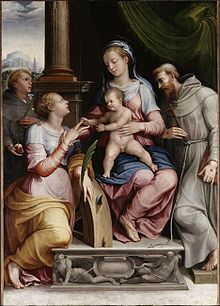
Orazio Alfani (c. 1510 – 1583) was an Italian painter of the Renaissance period, active in both Palermo and Perugia.
He is sometimes referred to as Orazio di Domenico or di Paris Alfani. Born near Perugia, he first trained with his father, the painter Domenico Alfani. His work was also influenced by the Mannerist painters Rosso Fiorentino and Raffaellino del Colle. In 1539, he went to work at the Cathedral of Palermo in Sicily, returning to Perugia in 1544. In 1573, he founded the Accademia del Disegno (Academy of Drawing) in Perugia, together with the architect Raffaello Sozi. This institution still exists today as the Accademia di Belle Arti Pietro Vannucci (Academy of Fine Arts "Pietro Vannucci").
Most of his paintings and frescoes are in museums and churches in Perugia and Palermo. Among his best known paintings is The mystical marriage of Saint Catherine, which was painted in 1549.
Orazio Alfani died 1583 in Rome. His son, of the same name, was also a painter.
References
- Ticozzi, Stefano (1830). Dizionario degli architetti, scultori, pittori, intagliatori in rame ed in pietra, coniatori di medaglie, musaicisti, niellatori, intarsiatori d'ogni etá e d'ogni nazione (Volume 1). Milan: Gaetano Schiepatti. p. 39.
- ^ N.N.: Alfani, Orazio, La Mia Umbria. In Italian. URL last accessed 2007-08-08.
- N.N.: Pietro Vannucci Fine Arts Academy Archived 2007-09-27 at the Wayback Machine, Commune of Perugia. URL last accessed 2007-08-08.
- Le mariage mystique de sainte Catherine is presently at the Louvre in Paris; see Index to the writings of Vivant Denon, director of the Louvre 1801 – 1815. URL last accessed 2007-08-08.
External links
- Accademia di Belle Arti in Perugia.
This article about an Italian painter born in the 16th century is a stub. You can help Misplaced Pages by expanding it. |